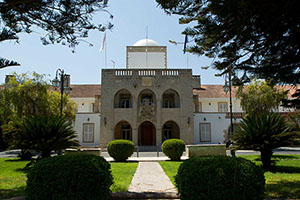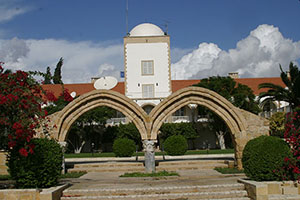 The Presidential Palace was formerly the Government House, the residence of the British Governor of Cyprus at the time of the British rule (1878-1960)
The Presidential Palace was formerly the Government House, the residence of the British Governor of Cyprus at the time of the British rule (1878-1960)
The first British High Commissioner Sir Garnet Wolseley, who arrived in Cyprus in 1878, stayed temporarily at the Metochi of Kykkos Monasteri, outside the walls of Nicosia. Soon he changed residence and lived at the Commissioner’s House, which was a wooden house imported from abroad and placed at the grounds of the present day Presidential Palace.
In 1925 the Commissioner’s house was renamed Government House.
In the course of the popular uprising of 1931 it was burned down and a decision was made to build a new Government House based on Cyprus traditional architecture.
The plans of the new Government House were prepared by a British firm and its construction was undertaken by the Cyprus Public Works Department. It was preceded by visits to various traditional buildings in Cyprus in the course of which worthwhile local architectural elements were recorded and copied.
The Byzantine and gothic elements, but also some Turkish elements, compose the architecture of the building. The series of columns on the ground floor are based on a similar construction at the Aheiropoiitos Monastery near Lapithos. The carved capital and the bases of the columns were chosen from designs from Kythrea, Lamboussa and Nicosia. The proportions of the tower at the centre of the building were taken from the Colossi Castle. In the original drawing, the roof of the castle was supposed to be made with tiles in the shape of pyramid, but for certain practical reasons and in order to give a Byzantine element to the building it was replaced by a dome.
 On the southern side of the building two series of gutters are protruding. The lower four represent human forms. They personify the overall foreman, the chief builder, the chief carpenter and the “unknown worker”. The other four gutters, which are higher up, represent the characteristic animals of Cyprus - the ox, the donkey, the camel and the sheep. For the general construction of the building a special stone (porous limestone) from Yerolakkos was used, for its pale grey-yellow colour, its hardness and resilience. For the interior (fire-places, staircases etc) limestone from the Limassol area, was used.
On the southern side of the building two series of gutters are protruding. The lower four represent human forms. They personify the overall foreman, the chief builder, the chief carpenter and the “unknown worker”. The other four gutters, which are higher up, represent the characteristic animals of Cyprus - the ox, the donkey, the camel and the sheep. For the general construction of the building a special stone (porous limestone) from Yerolakkos was used, for its pale grey-yellow colour, its hardness and resilience. For the interior (fire-places, staircases etc) limestone from the Limassol area, was used.
In the construction of the Government House, particular attention was given to timber. Timber from Cypriot forests (eucalyptus, pine, plane tree, cypress, walnut tree, mulberry) and from various parts of the British Empire, such as Burma and Canada, was used. The door of the main entrance was created based on the model of the Monastery of St. Chrysostomos at the Pentadaktylos mountain range. Every plate was formed by at least 288 small wooden pieces from six different trees, joined together without nails or screws. In this way a possible twisting was avoided. The carved roof beams and the reed mats of the roof were clearly of Cypriot origin. The supports of the roof beams in the main rooms were removed from the old house, which was demolished. Certain decorative elements inside the building and mainly the staircase leading to the upper floor, were copies of ancient artefacts, while the curtains were hand-embroidered with Cypriot decorative motifs.
Following Cyprus’ independence and the departure of the British Governor in 1960, the Government House became the official Presidential Palace of the Republic of Cyprus.
The Presidential Palace was destroyed on July 15, 1974 during the coup against Ethnarch Makarios. Everything was burned down, except the standing walls which were damaged in the fire.
The Palace was rebuilt a few years later with financial aid from Greece and since 1979 it is used as the office and the residence of the President of the Republic.
Environmental Management System
In a rapidly changing world, we consider the protection and preservation of the environment are vital requirements for the survival of humanity. Compliance with legal requirements, the prevention of environmental pollution and the protection of workers, as well as the continuous effort to improve the environmental performance, are the key pillars of our environmental policy, aiming at sustainable development and better quality of life for the whole society. At the Presidential Palace, since 2017, an Environmental Management System has been developed and applied, relying on the instructions of the European Regulation -EMAS.
The Environmental Management System is supervised and certified annually by the Cyprus Certification Company.